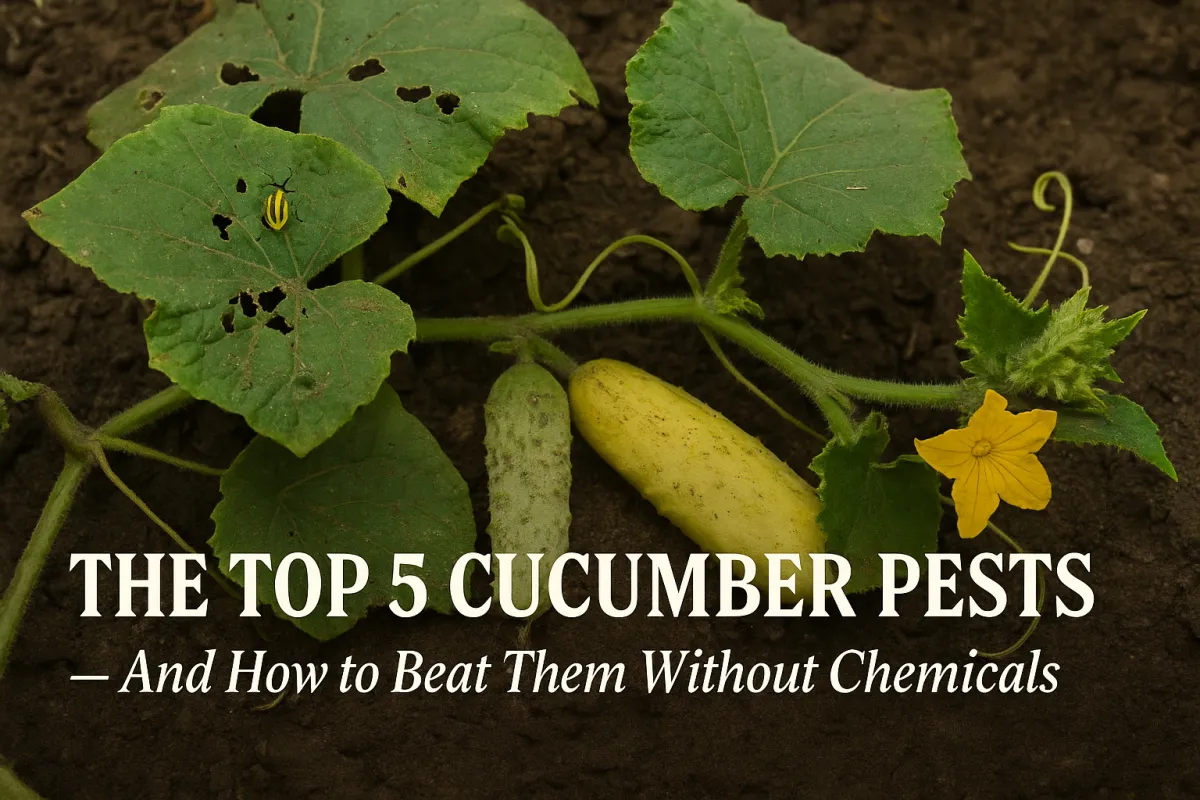
The Top 5 Cucumber Pests—And How to Beat Them Without Chemicals
The Top 5 Cucumber Pests—And How to Beat Them Without Chemicals
I still remember my first real cucumber crop—the one I actually planned for. I’d built the trellis, amended the bed, even planted companion flowers nearby. It looked like I knew what I was doing… right up until the leaves wilted, holes showed up overnight, and fruit just stopped forming. I had no clue what hit me.
Turns out, pests don’t wait until you’re ready. They show up early, multiply fast, and can wreck a bed before you’ve had your first harvest. If you’ve found yourself staring at curled leaves, sticky stems, or fruit that shrivels before it fills out, this guide is for you.
Here’s how to spot the five biggest cucumber pests—and how to beat them without chemicals.
🥒 Quick Guide: What to Watch for by Zone
PestPeak ActivityUSDA Zones Most AffectedEarly Warning SignCucumber BeetlesSpring to Early SummerZones 5–9Chewed cotyledons, striped or spotted beetlesAphidsLate Spring to Mid SummerAll zonesSticky residue, curled or yellowing leavesSpider MitesHot, Dry SpellsZones 6–10Bronze speckling, fine webbingSquash BugsEarly to Mid SummerZones 6–9Bronze egg clusters, wilting stems
Print this out and tack it near your garden journal. Timing matters.
1. Cucumber Beetles: Striped, Spotted, and Always Trouble
These guys are small, fast, and relentless. You’ll see either striped (yellow with black lines) or spotted (yellow with black dots) varieties, and both can do serious damage fast.
Damage:
Chew through young leaves, stems, and roots
Spread bacterial wilt, which causes sudden vine collapse
Early Signs:
Yellow-orange eggs at the base of stems
Small chew marks on young leaves
Adult beetles hiding in blossoms
Natural Solutions:
Row Covers: Keep them on until flowers appear, then remove for pollination
Trap Crops: Plant Blue Hubbard squash nearby—it draws beetles away like a magnet
Beneficial Nematodes: Apply to soil early to attack larvae underground
Grandma’s Tip:
“Don’t plant your whole row at once. Let the first round take the heat—you’ll learn what’s lurking.”
2. Aphids: The Sticky Little Farmers
If your cucumber leaves are curling inward or coated in a shiny film, check underneath—aphids are likely hiding in plain sight. They're usually green but can be black or gray depending on your zone.
Damage:
Suck sap from tender growth
Attract ants that protect them
Leave behind sticky honeydew that causes mold
Natural Solutions:
Blast with Water: A firm spray dislodges colonies without harming plants
Neem Oil or Insecticidal Soap: Apply weekly, especially to undersides of leaves
Encourage Predators: Plant dill, calendula, or alyssum to attract lacewings and ladybugs
DIY Aphid Spray:
1 qt water
1 tbsp Castile soap
5 drops peppermint oil
Spray in the evening, repeat every 5–7 days.
3. Spider Mites: The Hot-Weather Menace
You won’t see them until the damage is done. In dry, dusty gardens, spider mites thrive and multiply fast. Their hallmark is bronze speckling and fine webbing between leaves.
Damage:
Speckled yellow or bronze leaves
Webbing in plant crevices
Premature leaf drop
Natural Solutions:
Raise Humidity: Mist plants every morning to discourage mite activity
Garlic-Chili Tea: Blend a bulb of garlic, one hot pepper, and a quart of water. Let steep 24 hours, strain, and spray
Release Predators: Minute pirate bugs or predatory mites if you’re ordering online
Grandma’s Tip:
“Dry leaves invite trouble. If your boots don’t get a little damp walking through, it’s too dry under there.”
4. Squash Bugs: Not Just for Squash
These flat, shield-shaped insects will make a home on your cucumbers if squash isn’t nearby. They pierce vines and suck out fluids, leading to wilt and collapse.
Early Signs:
Bronze eggs laid in clusters under leaves
Adults hiding at the base of stems
Sudden yellowing or wilting despite moist soil
Natural Solutions:
Manual Removal: Scrape eggs with duct tape or collect adults into soapy water
Trap Boards: Lay a plank near the base overnight, collect and crush bugs each morning
Diatomaceous Earth: Dust around the base of vines weekly (especially after rain)
Companion Plant Tip:
Interplant nasturtiums and radishes to confuse and repel bugs naturally
5. Prevention Is the Best Defense
Truth is, once pests take over, it’s a scramble. The better path is layering your defenses from the start.
Your Organic Pest Prevention Stack:
Row Covers (early only): Keep flying pests off young plants
Neem Oil: Apply at dusk to avoid harming pollinators
Companion Planting That Works:
Radishes to repel beetles
Dill and fennel to attract lacewings
Marigolds to deter nematodes and beetles
Plant Diversity: Avoid monoculture. Mix cucumbers with herbs, flowers, and squash to throw off pest patterns.
Grandma’s Tip:
“A mixed garden’s a strong garden. Bugs don’t settle where they get confused.”
🎁 Download: Cucumber Pest ID & Control Chart (by Zone)
Includes timing, early signs, treatments, and companion plants to print and keep in your shed.
[Insert call-to-action button here]
👣 Your Cucumber Pest Game Plan
Here’s what to do this week:
Walk your rows. Look under leaves, near soil line, and at the base of stems.
Take notes. Snap a few photos if needed.
Act early. Remove what you can by hand, then layer in your defenses.
You don’t need sprays with warning labels.
You just need timing, attention, and a little grit.
Let your cucumbers thrive—without the chemicals.


Facebook
Instagram
X
Youtube